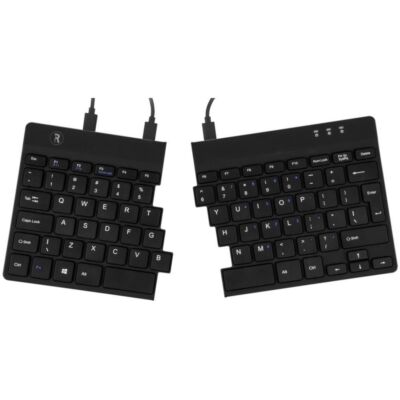Ergonomic keyboard
Computer work is a major cause of RSI/CARPAL complaints. Incorrect use of a keyboard is a significant risk factor. An ergonomic keyboard is an excellent tool for preventing these complaints. There are many variations of these keyboards, such as mini keyboards and adjustable keyboards. Personal preference plays an important role in choosing an ergonomic keyboard.
What is an ergonomic keyboard?
An ergonomic keyboard is a type of keyboard designed to provide the user with a more comfortable and natural typing position, reducing the risk of fatigue, pain, or injury to the hands, wrists, and arms.
An ergonomic keyboard often has a special shape or layout that allows the user to keep their wrists in a neutral position, reducing pressure on the joints and nerves. It may also have a split design, where the keyboard is divided into two parts. This allows the user to adjust the angle between the two parts to reduce strain on the wrists and arms.
Color
Layout
Brand
Control type
Desired Relaxation
Numeric
Key types
Keyboard connection
Desired relaxation
Why choose an ergonomic keyboard?
An ergonomic keyboard offers several benefits to users, particularly for those who spend a significant amount of time working on a computer. Here are a few reasons why you should opt for an ergonomic keyboard:
Reduction of pain and injury
An ergonomic keyboard can help reduce pressure on the joints, muscles, and nerves in the hands, wrists, arms, and shoulders. This can result in less pain and a lower risk of injury, especially during prolonged use of a standard keyboard.
Improvement of posture
An ergonomic keyboard is designed to promote a more natural hand and wrist position. This contributes to better overall posture while typing and can help prevent issues with the neck, back, and shoulders.I
Increased productivity
By using an ergonomic keyboard, users can work more comfortably and for longer periods without experiencing fatigue or pain. This can increase productivity and reduce the likelihood of errors.
Prevention of RSI/CARPAL complaints
Ergonomic keyboards are essential for preventing RSI/CARPAL complaints. RSI/CARPAL is a collective term for complaints in the neck, shoulders, back, arms, elbows, wrists, hands, and fingers. These complaints are typically caused by repetitive movements and prolonged static postures. Sufficient variation and movement during work are crucial, and maintaining a healthy working posture is essential. The right tools, such as an ergonomic keyboard, can assist in achieving that.
Types of ergonomic keyboards
Using an ergonomic keyboard is highly recommended for individuals who engage in extensive computer work. There are various types of keyboards to choose from, suitable for use with both desktop computers and laptops. Here are different types of ergonomic keyboards:
Mini Keyboards
A mini keyboard reduces the reach to the mouse, lowers muscle tension in the forearms, and is generally more comfortable than a standard keyboard. Compact keyboards are ergonomic because they omit the numeric pad, reducing the distance to the mouse and enabling typing within the shoulder line. This reduces the strain on the shoulders and forearms, significantly decreasing the risk of RSI complaints. Mini keyboards are compact and easy to carry, making them ideal for mobile workstations as well.
Split keyboards
These curved keyboards are typically height-adjustable, allowing the wrists to be positioned at a natural angle. Adjustable split keyboards promote a neutral and relaxed position for the forearms and wrists. These keyboards are available for both fixed and flexible workstations.
Numeric keypads
If the numeric section of the keyboard is rarely used, it's better to use a keyboard without a numeric pad, reducing the reach to the mouse. However, a numeric keypad is essential for individuals working extensively with numbers. External numeric keypads can be used in such cases. They are connected separately from the keyboard and can be placed to the right or left of the main keyboard.
Medical keyboards
Waterdichte toetsenborden en afwasbare toetsenborden zijn ideaal in omgevingen waar hygiëne belangrijk is en waar veel met vloeistoffen gewerkt wordt. Deze medische toetsenborden zijn namelijk eenvoudig en snel te reinigen.
Wireless or wired ergonomic keyboards??
Ergonomic keyboards are available in both wired and wireless versions, each with its own advantages and disadvantages.
Wired keyboards generally have less delay and interference compared to wireless keyboards, making them better suited for gamers and users who demand high responsiveness. Additionally, wired keyboards do not require batteries and do not need to be recharged, making them more reliable in some respects. On the other hand, a wired keyboard may be less flexible in terms of placement and the cable may get in the way or create a cluttered workspace.
Wireless keyboards offer more flexibility in terms of placement and can help reduce cable clutter on the desk. They are also portable and easier to use with multiple devices. One drawback of wireless keyboards is that they are often more expensive than wired keyboards and can be affected by interference from other devices or wireless signals in the vicinity.








